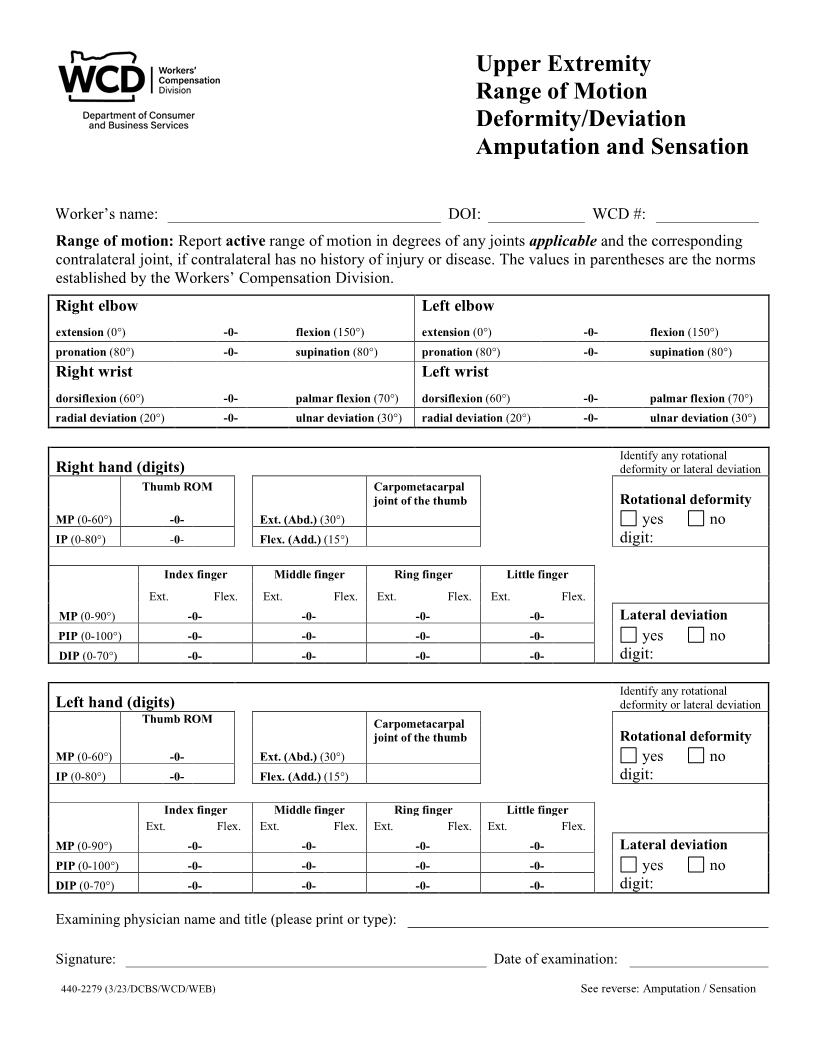
Last updated: 10/11/2023
Upper Extremity Range Of Motion Deformity Deviation Amputation And Sensation {2279}
Start Your Free Trial $ 13.99What you get:
- Instant access to fillable Microsoft Word or PDF forms.
- Minimize the risk of using outdated forms and eliminate rejected fillings.
- Largest forms database in the USA with more than 80,000 federal, state and agency forms.
- Download, edit, auto-fill multiple forms at once in MS Word using our Forms Workflow Ribbon
- Trusted by 1,000s of Attorneys and Legal Professionals
Description
Upper Extremity Range of Motion Deformity/Deviation Amputation and Sensation Worker's name: DOI: WCD #: Range of motion: Report active range of motion in degrees of any joints applicable and the corresponding contralateral joint, if contralateral has no history of injury or disease. The values in parentheses are the norms established by the Department of Consumer and Business Services. Right elbow extension (0°) pronation (80°) Left elbow -0-0- flexion (150°) supination (80°) extension (0°) pronation (80°) -0-0- flexion (150°) supination (80°) Right wrist dorsiflexion (60°) radial deviation (20°) Left wrist -0-0- palmar flexion (70°) ulnar deviation (30°) dorsiflexion (60°) radial deviation (20°) -0-0- palmar flexion (70°) ulnar deviation (30°) Identify any rotational deformity or lateral deviation Right hand (digits) Thumb ROM MP (0-60°) IP (0-80°) Carpometacarpal joint of the thumb Ext. (Abd.) (30°) Flex. (Add.) (15°) Middle finger Ext. -0-0-0- Rotational deformity -0-0Index finger Ext. Flex. -0-0-0- yes digit: Ring finger Ext. -0-0-0- no Little finger Ext. -0-0-0- Flex. Flex. Flex. MP (0-90°) PIP (0-100°) DIP (0-70°) Lateral deviation yes digit: no Left hand (digits) Thumb ROM MP (0-60°) IP (0-80°) Identify any rotational deformity or lateral deviation Carpometacarpal joint of the thumb Ext. (Abd.) (30°) Flex. (Add.) (15°) Middle finger Ext. Flex. -0-0-0- Rotational deformity -0-0Index finger Ext. Flex. yes digit: Ext. no Ring finger Flex. -0-0-0- Little finger Ext. Flex. -0-0-0- MP (0-90°) PIP (0-100°) DIP (0-70°) -0-0-0- Lateral deviation yes digit: no Examining physician name and title (please print or type): Signature: 440-2279 (6/10/DCBS/WCD/WEB) Date of examination: See reverse: Amputation / Sensation American LegalNet, Inc. www.FormsWorkFlow.com Amputation and Sensation Of the Upper Extremity (side 2) Amputation or resection (without reattachment) N/A For the thumb: check the box that applies and, on the illustrations, indicate the most proximal level of amputation as specified below: skin (dermis) only significant flesh or tissue loss only (no bone) bone involvement to mid-shaft of the distal phalanx proximal to/including mid-shaft of the distal phalanx to/including the head of the proximal phalanx proximal to the head of the proximal phalanx R For the fingers: check the box that applies and, on the illustrations, indicate the most proximal level of amputation as specified below: skin (dermis) only significant flesh or tissue loss only (no bone) bone involvement to mid-shaft of the distal phalanx proximal to/including mid-shaft of distal phalanx to the distal epiphysis of the middle phalanx proximal to the distal epiphysis (head) of the middle phalanx to mid-shaft of the middle phalanx proximal to the mid-shaft of middle phalanx to/including the distal epiphysis of the proximal phalanx L For reattached digits, indicate any loss of overall length. For amputations, proximal to the carpometacarpal joints, indicate the most distal bony landmark involved in the amputation. Sensation N/A proximal to the distal epiphysis (head) of the proximal phalanx On the illustrations, mark and grade palmar surface (volar) sensation. Grade 1: normal (two-point discrimination six millimeters or less) Grade 2: less than normal (two-point discrimination 7-10 millimeters) Grade 3: protective (two-point discrimination 11-15 millimeters) Grade 4: total loss (two-point discrimination >15 millimeters) R 440-2279 (6/10/DCBS/WCD/WEB) American LegalNet, Inc. www.FormsWorkFlow.com L








